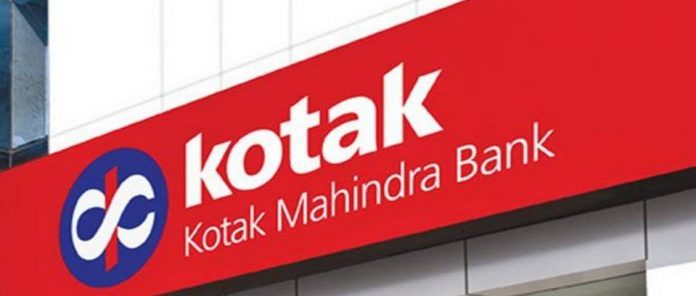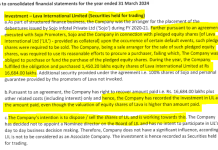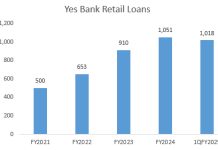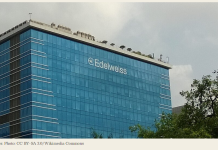Hemindra Hazari BANKING BUSINESS ECONOMY 12/APR/2017
Uday Kotak’s much hyped press conference on March 29 promised a bang. But all we got was a whimper. Kotak’s announcement was a new digital-based saving account, christened “811”, no doubt in honour of the Modi government’s demonetisation move, which was announced on November 8. It is a curious naming attempt that reminds one of the 9/11 or 26/11 attacks.
Kotak believes the scheme will double the bank’s eight-million customer base in 18 months. Prior to the press conference, the financial television press unwittingly delivered Kotak Mahindra Bank (KMB) much publicity by broadcasting a “countdown” throughout the day to the bank’s event, probably in anticipation of a rumoured merger and acquisition announcement.
To say that Kotak made no such announcement is an understatement.
Shareholding pattern
The press conference once again focused attention on the need for Kotak to divest part of his holdings to meet regulatory timelines. The RBI had laid down norms in 2013 requiring promoters of private banks to reduce their holdings to 15% within 12 years of the start of operations, which in Kotak’s case would mean by March 31, 2015. However, to date Kotak holds over 30% of KMB, thanks to the RBI’s special ‘forbearance’. What is even more remarkable, however, is that he can put off selling his excess stake till 2020.
By permitting Kotak to have a higher stake in the bank than allowed in its norms, the regulator has given him significant excess monetary gains at the cost to the bank’s non-promoter shareholders. These gains amount to an estimated Rs 40 billion as of March 31, 2017, and if the share price continues to rise till FY 2020, the gains to the promoter will be even higher.
Old wine in new bottle
As far as the ‘Kotak 811’ is concerned, it has turned out to be merely a digital variation of the no-frills savings account, with one added advantage: a user can instantaneously open an account by inputting his or her income tax Permanent Account Number (PAN) and a one-time-password enabled Aadhaar details in a mobile app.
Regulatory restrictions constrain the functionality of digital Know Your Customer (KYC) compliant accounts and limits are applied on such accounts. Indeed, the maximum amount a depositor can maintain in the ‘811’ account at any given point is Rs 1,00,000 and the maximum turnover in the account is Rs 2,00,000, after which it has to be mandatorily converted into a full KYC account through in-person verification at a branch.
The bank’s target of doubling its customers to 16 million in 18 months by using ‘811’ accounts for client acquisition appears overly ambitious as app-based and tech-oriented customers are already over-banked in the industry and limits of Rs 1,00,000 in ‘811’ may deter such customers. As a mechanism for financial inclusion it may also disappoint as low-income unbanked customers are typically unfamiliar with digital banking.
On the other hand, KMB might get another, shadier, class of customers. There is a risk in opening accounts based on digital KYC, as digital security and secrecy are extremely weak in India and there are media reports of Aadhaar details being leaked in cyberspace. Fraudsters can potentially open numerous digital accounts using other individuals’ PAN and Aadhaar details.
The issue then arises: why did Uday Kotak personally chair the press conference, fuelling high expectations among the media?
Jacking up share prices
The eternal pursuit of higher market capitalisation and personal wealth rules the capital market. In practically every bank presentation to investors and bank analysts, digital strategy is emphasised as a fundamental game changer. More importantly, it serves to boost market capitalisation. The timing of the 811 announcement is also relevant, as a day later, KMB announced a sale of upto 62 million shares (3.4% pre-issue dilution) aggregating to a maximum capital raise of Rs 54.1 billion at the current share price.
The stated objective of the issue was to pursue consolidation, acquisition of stressed assets, participation in a “Bad Bank”, organic growth, digital expansion and support its subsidiaries. Although the share capital issue would result in the promoters’ (essentially Kotak’s) shareholding reducing to 31.04%, it would still fall short of the RBI-mandated level of 30% by the end of June 2017. The shortfall will entail the promoters selling 1% of the company in the quarter ended June, and both these events require the share price to be enhanced to benefit the bank and its shareholders, including Uday Kotak.
The story of how Kotak retained the highest promoter shareholding amongst prominent new private sector banks reveals the undue influence of private financial capital on regulatory and policy-making. When the RBI gave Kotak a bank license in 2003, the stipulation was that promoters must have a minimum of 40% shareholding as per RBI’s 2001 guidelines. Subsequently, the RBI’s view changed and in its February 28, 2005 guideline it emphasised diversified ownership, with single entity or group of related entities holding a maximum of 10%; higher levels required RBI approval.
Thereafter, as per the RBI’s revised guidelines for licensing of new private banks issued on February 22, 2013, it stated that the promoter should have a maximum shareholding of 15% “within 12 years from the date of commencement of business of the bank.” For KMB, the RBI’s latest guideline meant that by February, 2015, the promoters’ shareholding should have been 15%. It appears, since the 2005 guideline, the RBI was discussing with KMB to bring down the promoter holding first to 15% and subsequently to 10%. Kotak apparently argued that the policy should be implemented for new bank licenses given post 2005 and not retrospectively as his market capitalisation would get impacted with a sudden large sale of shares.
In 2012, there was intense discussion in the Board for Financial Supervision on this issue and finally it was agreed to extend the deadline for KMB’s promoter shareholding. This was an abnormal regulatory forbearance. Since then, the RBI has been extending the deadline for KMB, and the latest notification stipulates that the promoter shareholding should be 30% by June 30, 2017, 20% by December 31, 2018 and finally, 15% by March 31, 2020. In all, that amounts to an extension of 5 years.
While Yes Bank and HDFC Bank have also higher than the 15% limit of promoter shareholding, the RBI was able to compel other banks like IndusInd (established in 1994, nearly a decade prior to KMB) to reduce promoter holding. KMB remains a glaring outlier, a beneficiary of RBI’s discretionary policy.

Source: KMB
This writer estimates that till March 31, 2017, the promoters, by not conforming to the regulatory stipulation of 15% holding by FY’2015, have benefited by a stupendous Rs 40 billion. The Wire sent KMB a detailed email with questions about this analysis, but the bank did not respond to the query.
Undue Gains to Kotak Bank Promoters as on March 31 2017 (values in Rs million)
| 1 | Share Price as on 31 March 2015 (Rs) | 657 |
| 2 | Share price as on 31 March 2017 (Rs) | 872 |
| 3 | Share price of Promoter sale of 27.7mn sold on 8 March 2017 (Rs) | 817 |
| 4 | Excess Promoter Holding as on 31 March 2017 32.08%-15%= 17% ( shares mn) | 314.70 |
| 5 | Value of 17% of Excess of Promoter in FY2015 (1*4) | 206,758 |
| 6 | Interest @ 7.5% on (5) for FY2016 | 15,507 |
| 7 | Outstanding Bal. on 1.4.2016 (5+6) | 222,265 |
| 8 | Interest @ 6.5% on (7) for FY2017 | 14,447 |
| 9 | Outstanding Bal. on 31.3.2017 (6+7) | 236,712 |
| 10 | Market Value of Excess Holding as on 31.3.2017 (4*2) | 274,418 |
| 11 | Gain to Promoters without dividend & Sale of Shares (10-9) | 37,706 |
| 12 | Shares Sold by Promoter on 8 March 2017 (mn) | 27.70 |
| 13 | Total Excess Shares (mn) (4+12) | 342.40 |
| 14 | Dividend per share for FY2015 & FY2016 (Rs0.9+Rs0.5) (Rs) | 1.40 |
| 15 | Dividend income for 2 years on Total Excess Shares (13*14) | 479 |
| 16 | Gain/share of Promoter sale of 8 March 2017 (3-1) (Rs) | 160 |
| 17 | Gain on 27.7mn shares sold on 8.3.17 (16*12) | 4,432 |
| 18 | Cost of 27.7mn shares if sold on 31.3.15 (1*12) | 18,199 |
| 19 | Interest @ 7.5% in FY2016 | 1,365 |
| 20 | Closing Bal. Value of 27.7mn shares sold in FY2016 (18+19) | 19,564 |
| 21 | Interest @ 6.5% for FY2017 | 1,272 |
| 22 | Closing Bal. Value of 27.7mn shares sold in FY2017 (20+21) | 20,835 |
| 23 | Total Value of 27.7mn sold by Promoter (3*12) | 22,631 |
| 24 | Gain for Promoters on 27.7mn shares sold (23-22) | 1,795 |
| 25 | Total Excess Gain to Promoters as on FY2017 (11+15+24) | 39,981 |
Values in Rs million unless stated otherwise
Indeed, the ‘regulatory forbearance’ has resulted in Kotak, the principal shareholder, enjoying the benefit as the share price rose from Rs 657 in FY 2015 to Rs 872 in FY 2017. If the share price of KMB keeps rising till FY 2020 (assuming the regulator does not extend the deadline further), the gains will be even higher for Kotak at the cost of the non-promoter shareholders.
The business media and the 32 banking analysts tracked by Bloomberg who cover KMB, the majority of whom maintain a ‘Buy’ recommendation and who shower paeans of praise on Kotak and the bank, do not seem to be concerned regarding the loss to non-promoter shareholders’ wealth at the bank.
The RBI’s undue largesse should be seen in the light of the close relationship Kotak enjoys with the RBI and the Securities Exchange Board of India (SEBI). Uday Kotak, despite being a non-academic, is on the Research Advisory Council at the Centre of Advanced Financial Research and Learning, an institute promoted by the RBI. In October 2015, nearly one year after SEBI’s DLF order (October 10, 2014), which exposed the pivotal role played by KMB in engaging in “sham transactions” to “camouflage the association of DLF with its three subsidiaries”, Kotak and Arundhati Bhattacharya (executive chairperson, SBI) were invited to lecture the senior management (chief general managers, executive directors, deputy governors and the governor) of the RBI at their internal conference at Surajkund in Haryana on corporate governance. This was the first time serving bank CEOs had addressed an internal RBI senior management event.
Six months later in April 2016, Raghuram Rajan, as RBI governor, delivered the inaugural Kotak Family Distinguished Lecture on “India in the global economy,” at Columbia University. Urjit Patel, the RBI’s publicity-shy and reticent current governor, who till date has delivered only a single public speech since taking charge, is going to present the Third Kotak Family Distinguished Lecture on April 24 at the same venue. Whether it is appropriate for a banking regulator to be publicly associated with a private event of a bank promoter directly under its supervision does not seem to be an issue for RBI governors.
Kotak sits on the board of governors of the National Institute of Securities Markets (NISM), a public trust established by SEBI. He is also a member of the Primary Market Advisory Committee of SEBI, a body entrusted with the development of the primary market and advocating changes in legal framework to introduce simplification and transparency in systems and procedures in the primary market. It is ironic that a member of such a committee is the executive vice-chairman and promoter of a bank which was found to be engaged in “sham transactions” to camouflage the association of DLF with its subsidiaries while its investment banking subsidiary was lead managing the DLF Initial Public Offering (IPO) in June 2007.
As per KMB’s annual report for the year ended March 31, 2016, its wealth management division is “one of the largest and most respected wealth management businesses in India providing customised financial solutions to high net worth families (covers 40% of India’s top 100 families in Forbes India Rich List 2015).” Globally, the Swiss bank model stands exposed for providing various customised financial solutions to their myriad super wealthy global clientele which finally resulted in the ire of the US and European governments, in turn curtailing their business model. Banks which are excessively dependent on catering to the needs of the super wealthy, which in India’s case means many promoter families in the corporate world, need to be carefully scrutinised by regulators on compliance.
Strangely, since the SEBI order, the RBI, the banking regulator and SEBI do not appear to be concerned that a commercial bank was facilitating financial transactions to disguise the ownership of subsidiaries; nor that the bank’s investment banking subsidiary is introducing such companies to the capital market. As Kotak Mahindra Capital is a prominent investment bank, ranked number 1 in IPOs and number 2 across all equity offerings by Prime Database in FY2016, vigilant regulators should have examined and investigated the role played by the Kotak group in all the companies that the group advised in the capital market and whether any further irregularities had taken place.
Cementing its regulatory capture, KMB has now named the newly-launched digital-only saving bank deposit ‘811’ in honour of Modi’s demonetisation decision of November 8. With the greying of the HDFC titans Deepak Parekh and Aditya Puri, Kotak appears to have donned the mantle of the doyen of private financial capital in India, with generous support from the banking regulator, the stock exchange regulator, the swooning business media and fawning banking analysts in the stock market.














